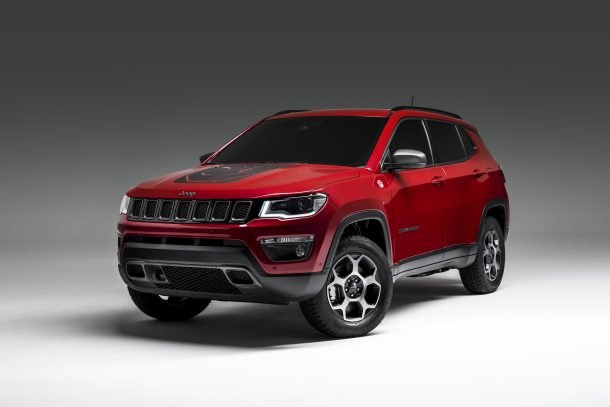Jeep's Green Wave Crashes Into Europe, Will Ripple Back to North America

Fiat Chrysler’s reputation as an automaker that scoffs at fuel economy mandates is slowly being chipped away. Never mind the much-loathed Fiat 500e; it was the Chrysler Pacifica Hybrid that really got the ball rolling, with eTorque-engined Ram 1500s upping the company’s green cred for 2019.
At this week’s Geneva Motor Show, the high-flying Jeep brand revealed the next salvo in its bid to lower corporate emissions while wooing eco-conscious (or heavily taxed) overseas buyers: Two crossovers, each bearing a plug-in hybrid drivetrain.
While American consumers can expect a plug-in Wrangler hybrid sometime in 2020, Jeep’s Tuesday reveal focused on more Euro-friendly models. The subcompact Renegade and compact Compass both gain a plug-in hybrid system that mates a rear-mounted electric motor with the brand’s potent new 1.3-liter turbocharged four-cylinder.
Debuting in the 2019 Compass, the gasoline engine makes 177 hp and 200 lb-ft of torque in U.S.-spec models. For these two plug-ins, FCA claims a combined output of 190 to 240 hp, with the Compass understandably earning the highest power figure.
All-electric range for both Renegade and Compass is 31 miles, with each vehicle said to be capable of 80 mph in EV mode and a seven-second 0-62 mph sprint. The Renegade and Compass PHEV mark the debut of Jeep’s eAWD system, which forgoes a mechanical connection between front and rear drive wheels.
“Thanks to the new electric all-wheel-drive technology (eAWD), traction to the rear axle is not provided by a prop shaft but through a dedicated electric motor,” FCA said. “This allows the two axles to be separated and to control the torque independently in a more effective way than a mechanical system.”
In last year’s five-year plan, the automaker said it hoped to offer 12 electrified powertrains globally by 2022, split among mild hybrids, hybrids, plug-ins, and fully electric vehicles. North America is said to get eight Jeep plug-ins by that target year, so expect to see this duo offered stateside, probably by the end of next year. The automaker has already revealed the Renegade PHEV’s availability in early 2020.
Last week’s plant investment announcement saw FCA reveal the future production of four PHEVs on American soil, as well as capacity for BEVs. Sitting atop Jeep’s green pyramid will be the plug-in Wagoneer and Grand Wagoneer.
[Images: Fiat Chrysler Automobiles]

More by Steph Willems
Latest Car Reviews
Read moreLatest Product Reviews
Read moreRecent Comments
- Pig_Iron This message is for Matthew Guy. I just want to say thank you for the photo article titled Tailgate Party: Ford Talks Truck Innovations. It was really interesting. I did not see on the home page and almost would have missed it. I think it should be posted like Corey's Cadillac series. 🙂
- Analoggrotto Hyundai GDI engines do not require such pathetic bandaids.
- Slavuta They rounded the back, which I don't like. And inside I don't like oval shapes
- Analoggrotto Great Value Seventy : The best vehicle in it's class has just taken an incremental quantum leap towards cosmic perfection. Just like it's great forebear, the Pony Coupe of 1979 which invented the sportscar wedge shape and was copied by the Mercedes C111, this Genesis was copied by Lexus back in 1998 for the RX, and again by BMW in the year of 1999 for the X5, remember the M Class from the Jurassic Park movie? Well it too is a copy of some Hyundai luxury vehicles. But here today you can see that the de facto #1 luxury SUV in the industry remains at the top, the envy of every drawing board, and pentagon data analyst as a pure statement of the finest automotive design. Come on down to your local Genesis dealership today and experience acronymic affluence like never before.
- SCE to AUX Figure 160 miles EPA if it came here, minus the usual deductions.It would be a dud in the US market.




































Comments
Join the conversation
One question though: "Debuting in the 2019 Compass, the gasoline engine makes 177 hp and 200 lb-ft of torque in U.S.-spec models. For these two plug-ins, FCA claims a combined output of 190 to 240 hp, with the Compass understandably earning the highest power figure." --- Why would the Compass, being bigger and heavier (albeit not by much) get, "...understandably ... the highest power figure"? If they're using the same engine and the same eHybrid drive, they should get almost identical figures. When comparing the gasoline-only versions, the Compass actually realizes a slight reduction in economy compared to the Renegade despite the Renegade's less-aerodynamic nose.
Makes me wonder how they integrate the output of the elctric motor in back and the ICE up front. With mechanical AWD you get automatic correlation of front and rear axles. That's why Subaru kept its AWD system in their new hybrid. And no Mr Vulpine, I need no theorizing from you. Nothing I've read from you gives me any confidence you know what you're on about, and you're opinionated with it. I'm a mechanical engineer, so if you have some idea to fulminate upon, make it logical and defensible.